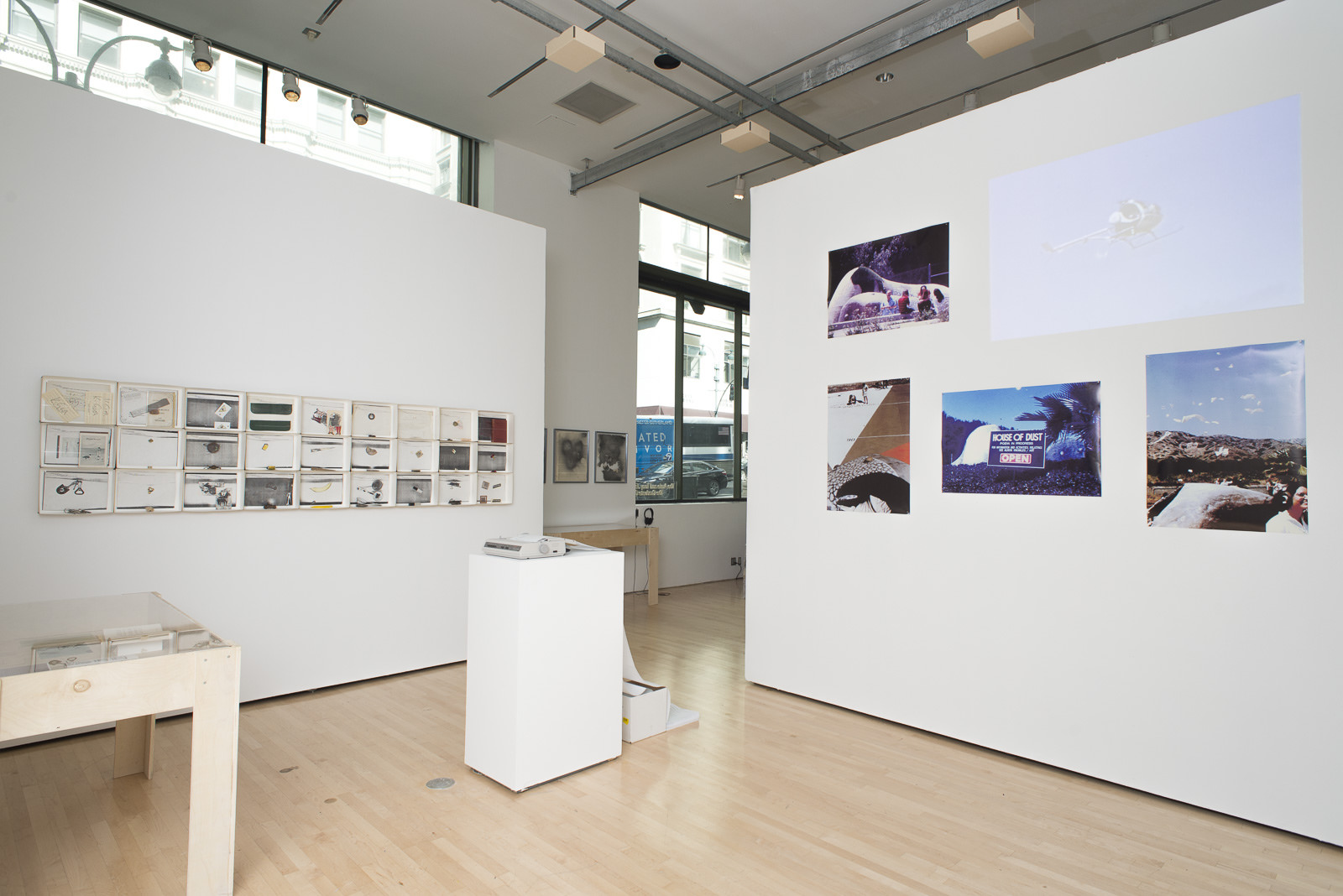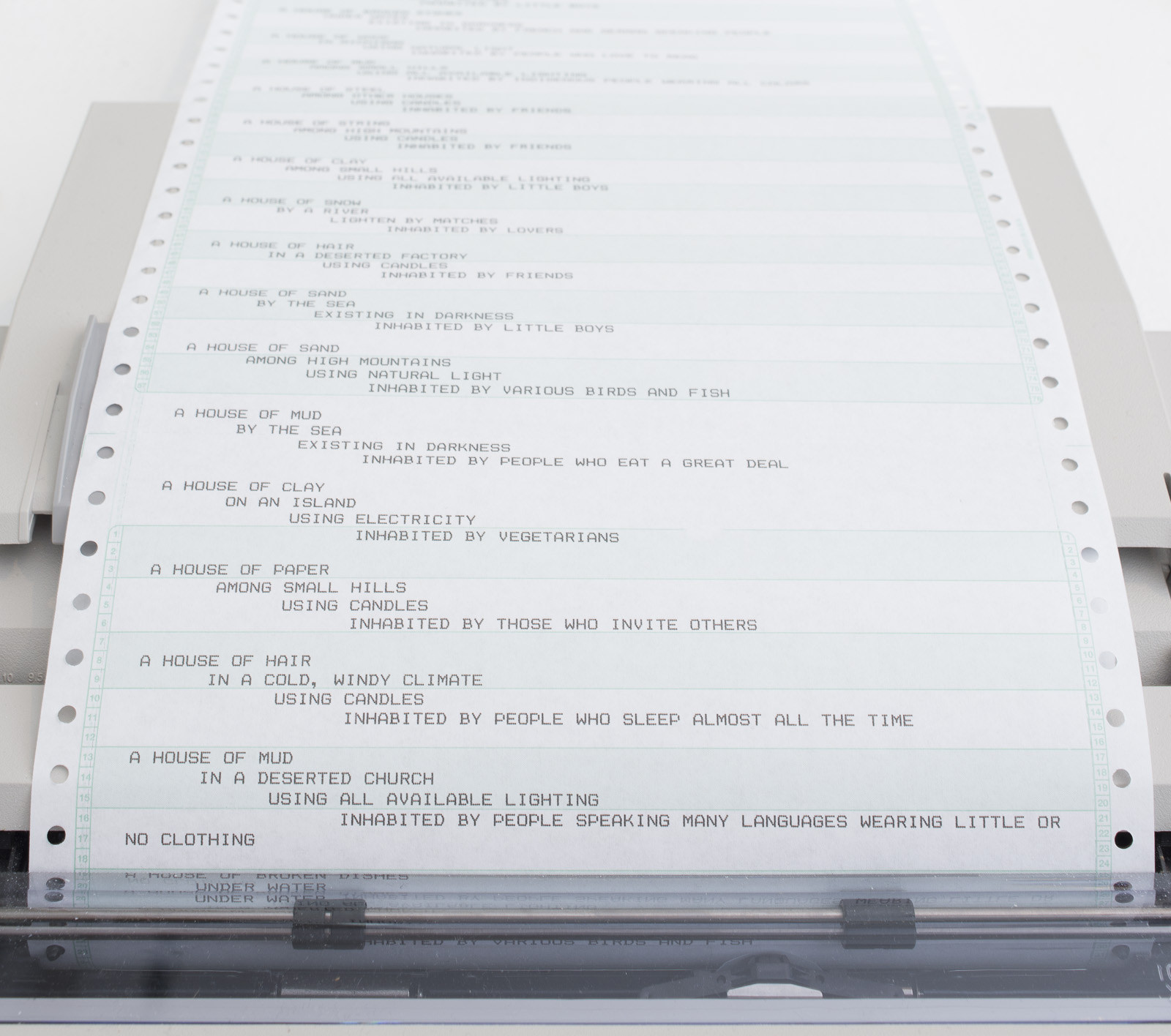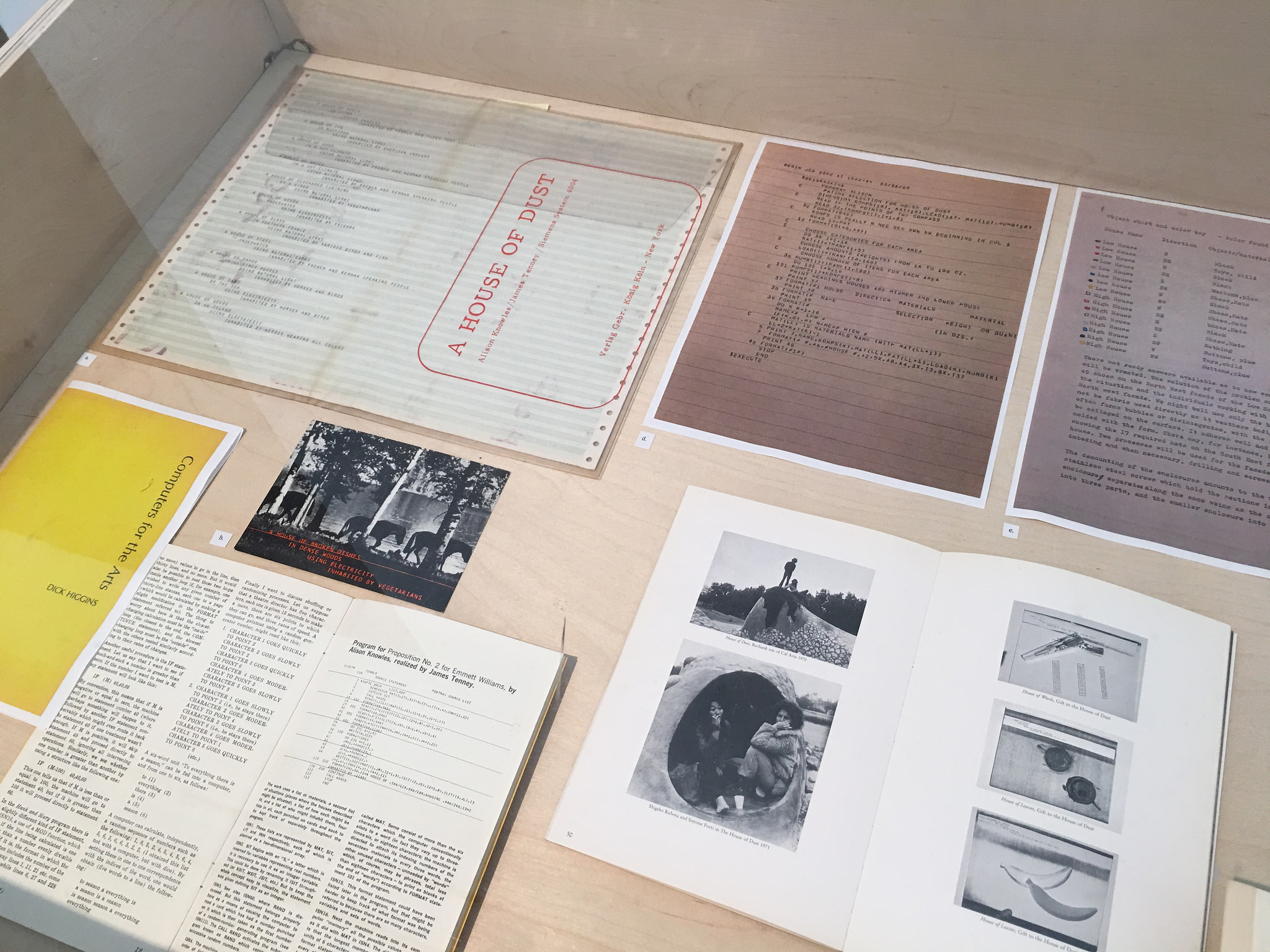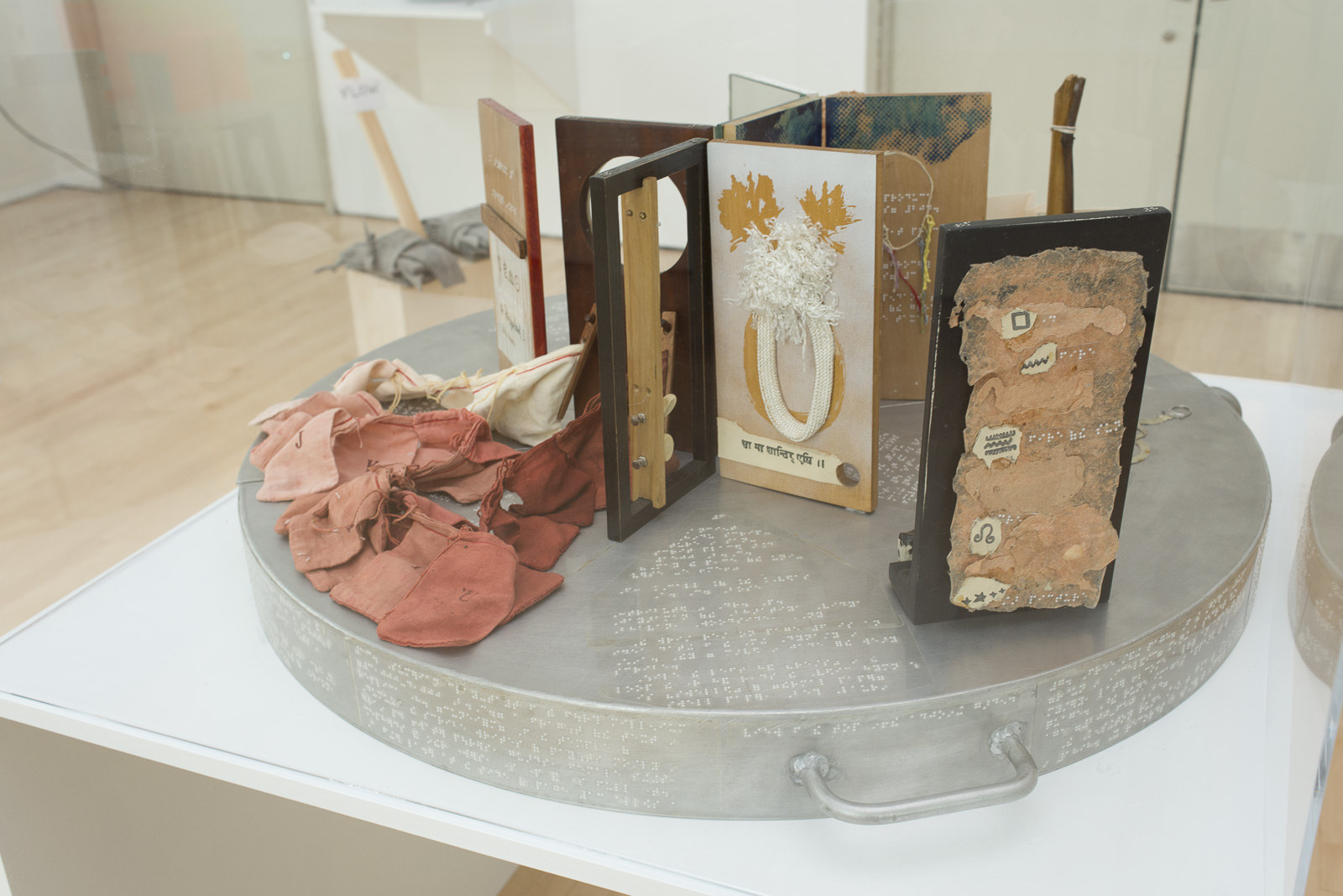The House of Dust by Alison Knowles
INHABITED BY PEOPLE WHO LOVE TO READ
THE HOUSE OF DUST
This room displayed The House of Dust in all its instantiations, including as a printed poem, an architectural structure, and a generative platform.
Alison Knowles, The House of Dust, poem, 1967/2016
Courtesy of Alison Knowles and James Fuentes, New York.
This printer displayed an exhibition copy of the computerized poem, originally written in FORTRAN, with the help of composer James Tenney. A new version of the poem’s algorithm was designed by Etienne De Boursetty for this exhibition.Archival images from The House of Dust at CalArts, ca. 1970-2
Images Courtesy of Alison Knowles and James Fuentes, NEW YORK.Film by Allan Kaprow, Helicopter, Alison Knowles and Norm Kaplan event, May 1971, at CalArts
Courtesy of The Getty Research Institute, Los Angeles.
This film documented an event in which the exhibition copies of the poem were dropped via helicopter onto The House of Dust under the direction of Knowles. While a student at CalArts, Norman C. Kaplan conceived and executed this “Computer Poem Drop” event as part of his class with the artist.
A vitrine contained materials that unfold the complexity of The House of Dust, its protocols, influences, and multiple variations.
On the left were physical manifestations of the poem itself, including the computer program as written with James Tenney, its publication, and an example from a series of postcards edited by the artist. The rest of the vitrine focuses on The House of Dust as architecture: When installed at the Penn South Housing Cooperative in Chelsea, Knowles collected objects from residents and children enrolled in neighboring schools. Utilizing the computer program “Patina selection for The House of Dust”, which randomly assigned the placement of these objects onto the built structure, she transformed its exterior surface through the participation of the local community.
When the work was installed at CalArts, Knowles used another score that was generated by a second computer program, Proposition IV (Squid) designed by Andrew Schloss, to generate new works inside and around the house. In this instance, she drew a dial with quadrants that corresponded to the cardinal directions and invited participants to place objects, or perform actions according to program, which supplied randomly assigned numbers, colors, and orientations. Her own interpretation of the protocol, which gave 99 Red North, consisted of 99 red apples arranged in three lines. Influenced by the gift events in Native American culture, the artist invited visitors to exchange what they wanted in place of an apple. This action was a development of one of her own previous scores, Giveway construction (1965).
Alison Knowles and James Tenney, A house of dust, Verlag Gebr. König, ca. 1972
Alison Knowles, House of Broken Dishes, postcard. Staeck editions, reprinted by Siglio Editions, 1968
Dick Higgins, Computers for the Arts, 1970
Cover and “Program for Proposition No. 2 for Emmett Williams by Alison Knowles realized by James Tenney.”*“Patina selection for The House of Dust”* program code and output, including object chart and color key.
Documentation of The House of Dust structure at CalArts and Knowles’s Gift Objects, 1971:
Bernd Schultz, et. al., Indigo Island: Artworks by Alison Knowles, Stadtgalerie Saarbrucken, 1995
Alison Knowles, Proposition IV (Squid) score, in Alison Knowles by Alison Knowles, Something Else Press, 1965
An exhibition copy of this poem, displayed on The House of Paper, is available for activation by the public.Photographs of the event 99 Red North
Jerome Rothenberg, “Gift Event,” in Shaking the Pumpkin Traditional Poetry of the Indian North Americas, Doubleday, 1972
Alison Knowles, “Giveaway Construction,” in Alison Knowles by Alison Knowles, Something Else Press, 1965
Gift Objects to The House of Dust, 1979-80
In anticipation of a planned move of The House of Dust to Minneapolis, the artist collected fifty objects from her friends and artistic community–including Philip Corner, Simone Forti, Geoffrey Hendricks, and Francoise Janicot–with the plan of embedding them onto the structure’s surface upon its arrival. The collected objects were Xeroxed and paired individually with a single quatrain from the poem. When the relocation of the house fell through, Knowles presented these objects in various exhibitions, positioned on a compass drawn on the floor.
OTHER WORKS BY ALISON KNOWLES
Videos of Alison Knowles’s The Big Book (1966-7)
This is a video showing Alison Knowles crawling through one of her seminal works that also combined language and architecture: The Big Book. The architecturally-sized book was comprised of eight pages each corresponding to a room inhabited by furniture and household objects.Alison Knowles, A Finger Book, 1982
This book is an architectural assemblage, originally meant to be manipulated by the viewer to reveal the tactility and materiality of language, hence the inclusion of Braille. Other linguistic systems represented in the work included Yoruba and Ashanti, a Vedic hymn, a sample of Inca Quipu, Shang pictograms, and Sumerian clay tablet fragments.Alison Knowles, Frijoles Canyon, audio recording of the performance map, 1992
In this sound piece, Knowles mixed the sounds of the New Mexican landscape with her own voice.Alison Knowles, Footnotes, 2000
These four “bricks” are part of a larger project by Knowles, titled Footnotes presented in the eponymous volume. This project played on the double meaning of the term “footnote” i.e., “notes created on foot” and “notes at the bottom of the page.” The work began with the artist’s sketchbooks, which accompanied her on daily walks throughout the years. These volumes were then dismantled, with each page serving as inspirations for the creation of sculptural works, including a number of colored bricks. These objects were then offered by Knowles to someone close to her; in exchange, she requested that they choose a title to be written on a label attached to the object, bearing the inscription “Footnotes”.Alison Knowles, Arizona (from the Times Samples series), 2006



